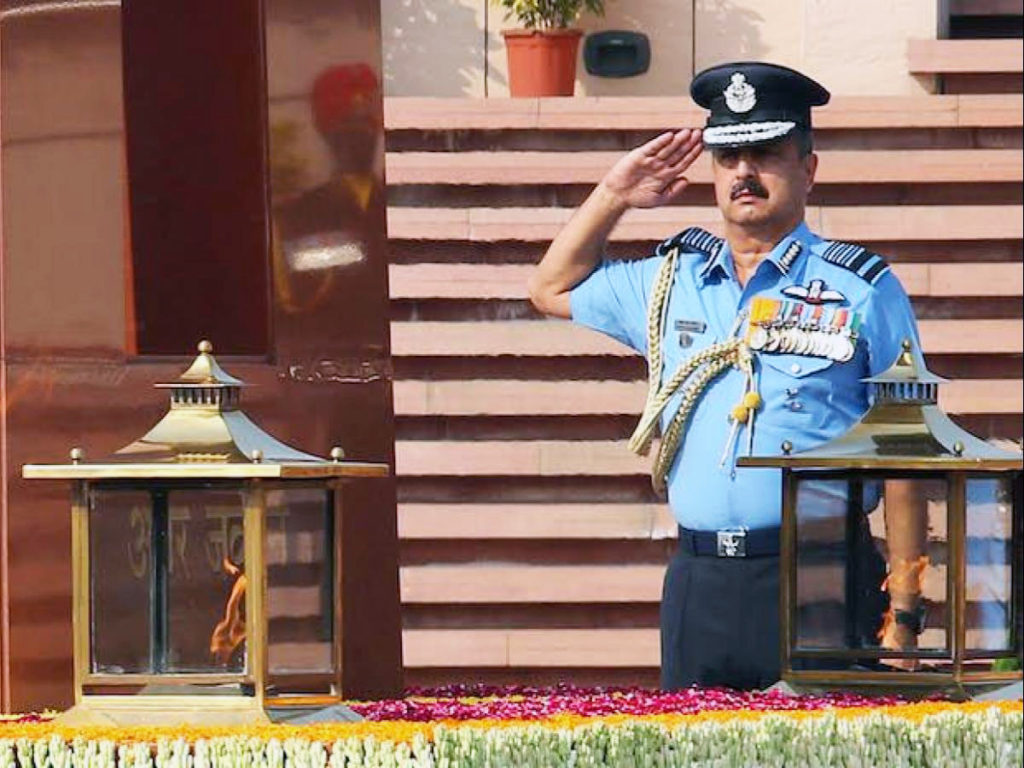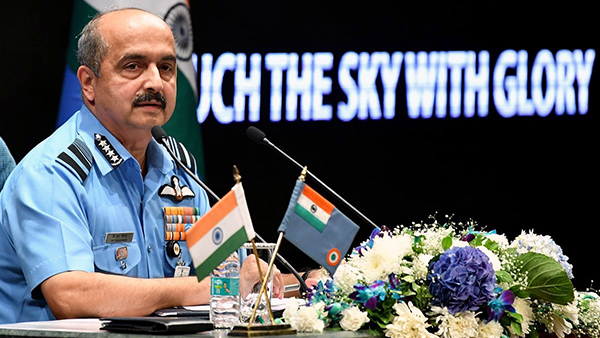Air Chief Marshal VR Chaudhari Takes Charge as CAS
Air Chief Marshal (ACM) Vivek Ram Chaudhari assumed office as Chief of Air Staff on 30 September 2021 facing a wide spectrum of challenges, including the reorganisation of India’s military into new theatre commands, the reservations expressed by the IAF about its “support” role and the visible depletion in operational air assets due to obsolescence and lack of new platforms, readiness for future war, the threat from China and the geopolitical flux that includes the US withdrawal from Afghanistan and the setback in Galwan apropos China which continues to fester.
The Threat From China
China has gone in for a major upgrade of its airbases facing India, with hardened shelters and other infrastructure to increase deployment of fighters and bombers, but its air force incurs “a huge penalty” in operating from such high-altitude areas, said the IAF chief.
“The capability of the PLAAF (Chinese air force) to launch multiple missions is limited. That is a weak area for them. We are fully prepared to deal with any situation and challenge in the region,” he added, at his maiden press conference as IAF Chief, on 5 October, ahead of IAF Day on October 8.
The high-altitude and rarefied air at Chinese air bases, like Hotan, Ngari Gunsa and Shigatse, severely limits the weapon and fuel-carrying capacity of fighters. IAF, however, can deploy fully-loaded Rafale and Sukhoi-30MKI fighters from bases like Bareilly, Hasimara, Tezpur and Chabua for strike missions across the frontier.
ACM Chaudhari said there is “nothing to fear about” the collusive threat from China and Pakistan. “Be assured, we are well-prepared to handle a two-front contingency,” he said, though he did flag concerns over the possibility of “western technologies” reaching China from Pakistan.
Two-front War
The IAF chief also said his force is fully prepared to deal with any security challenge in eastern Ladakh, and noted that new infrastructure created by the Chinese side in the region will not affect India’s combat capabilities.
ACM Chaudhari said the Chinese Air Force is still present on three air bases on their side of the Line of Actual Control but China’s capability to launch multiple high altitude missions would remain weak.
He added India is fully ready to deal with a “two-front” war scenario involving China and Pakistan. He said the only worry is Western technology passing from Pakistan to China.
“The prompt actions in response to developments in eastern Ladakh was a testament to the Indian Air Force’s combat readiness,” he said.


Future War
At the press conference, the Air Chief highlighted the paradigm change in future warfare including the non-kinetic, non-lethal challenges. He said IAF has its own strategy in place to have directed energy weapons, unmanned wingmen among other futuristic technologies. Indian Airforce is enhancing the offensive strike capability that has become even more potent with the induction of cutting edge weapons.
According to Air Chief, the Air Force have hardened its networks to avoid cyber attacks for which adequate safeguards are being taken to protect the critical infrastructure of the country.
On China’s capability to launch multiple high altitude missions, Air Chief Marshal said it would remain weak. ACM VR Chaudhari also said that PLAAF is still present along the LAC but this is not going to affect the IAF air operations.
In response to a question on threats faced by India, he said, “I can assure you that we are fully aware of the threats that we face, and our acquisitions, training, and tactics developed to counter such a threat”.
The IAF chief also said that the ability to “seamlessly integrate” new weapons, new data, into the network and train its personnel to operate them, and keep them “future-ready” was the way forward.
“I can say with some degree of confidence that the way we go about analysing the threat perception, carrying out global scan of the political situation, of the acquisitions and modernisation of the adversaries, and to counter that we plan are our own acquisition for air force, and linked to that is training, and development of new tactics,” he said.
“Every time you find there is an imbalance in technology and pure numbers, we counter it with better tactics and better training,” the IAF chief added.
Asked about the delivery of the S-400 air defence systems by Russia, the Air Chief said the first batch is expected to arrive within this year.
On the deployment of anti-drone technology, he said efforts are underway to enhance indigenous capabilities.
Decline in Squadron Strength
The decline in platforms is stark and from a strength of 42 combat squadrons in 2002, the IAF now operates barely 30. ACM Chaudhari noted that this shortfall in numbers would remain through this decade. “Even with planned inductions, the squadrons will remain around 35. The target of 42 will not be possible for 10-15 years,” said the IAF chief.
The existing four MiG-21 squadrons will be retired in the next three to four years. Moreover, Jaguar, Mirage-2000 and MiG-29 squadrons will also begin to be phased out towards the end of this decade.
The planned inductions of 73 Tejas Mark-1A jets and 10 trainers in the 2024-2028 timeframe under the Rs 46,898 crore deal inked with defence Hindustan Aeronautics in February 2021 will provide a fillip even as the sturdy MIGs are finally phased out.
A more optimistic scenario is envisaged for the next decade, when the IAF hopes to induct the indigenous fifth-generation Advanced Medium Combat Aircraft (AMCA) and the Multi-Role Fighter Aircraft (MRFA) — a new platform that would be built in India with a foreign entity, the “original equipment manufacturer” (OEM), and thereby move up to 35 squadrons.
The AMCA is “under design” and India’s track record in the design and manufacture of indigenous fighter aircraft is cost- and time-intensive. IAF plans to induct seven AMCA squadrons. “The DRDO has set aggressive timelines for the AMCA project, with deliveries slated to begin from the early years of the next decade. We are fully committed to the project,” said the IAF chief.
IAF also plans to get the “acceptance of necessity” next year for its long-pending mega “Make in India” project for 114 new fighters for over Rs 1.25 lakh crore. The request for information for 114 jets has just been issued. Rafale will obviously be the frontrunner in this, with India having already bought 36 of them under the Rs 59,000 crore deal inked with France in September 2016. The other six contenders are F/A-18 and F-21 (US), Gripen-E (Sweden), Sukhoi-35 and MiG-35 (Russia) and the Eurofighter Typhoon.
“Support Arm”
Asked about the recent remarks of Chief of Defence Staff (CDS) General Bipin Rawat that the IAF was a “support arm”, ACM Chaudhari said that in any conflict in the world, the air force has had multiple roles.
He said the roles vary from offensive strike and air transportation to supporting the army and maritime forces.
“There are various roles for air forces and it is true for the Indian Air Force. Capability of our training and equipment caters to multiple roles,” he said.
ACM Chaudhari underlined that no one service can go alone into any battle, and would “need the support of the other two services. It is true for all services. It is not that just that the IAF only is the support arm, the Army also at times has to support the IAF in its air operations”.
Theatrisation and Joint Commands
The CDS has been focussing on bringing convergence among the three services and restructuring military commands to effectively deal with future security challenges.
There has been a growing perception that the Indian Air Force has some reservations about the theaterisation programme.
ACM Chaudhari, strongly pitched for joint planning and operations among the three Services, but made it clear that structures and processes of theaterisation will have to take into account individual strengths and doctrines of the Army, Navy and Air Force.
“We are fully committed to integration and jointmanship. There is no doubt,” ACM Chaudhari said at the press conference on 5 October.
ACM Chaudhari supported his predecessor ACM RKS Bhadauria’s focus on the need for structures and processes to cater for future warfare. “That is the key element of restructuring into theatres. The strengths of each service need to be taken into account and need to be synchronised for the net combat capability of the nation,” he said.
The IAF chief also underlined that the doctrines of each service also need to be kept in mind while designing the structures, and added that his force’s concerns have been considered and deliberations and discussions are on.
Accidents
On being asked about a large number of accidents, IAF Chief said, the fact that we have had a large number of accidents on the MiG-21 fleet is not deniable. But data also shows that there has been a reduction in the no. of accidents in this fleet. Let me assure you that every aircraft that flies goes through all checks rigorously.













